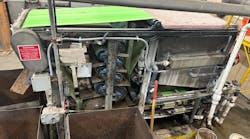Through self-assessment, in 2000 the city of Lancaster, Pa., determined that significant improvements were required to meet more stringent water quality treatment standards at its two water treatment facilities: the 24-million-gal-per-day (mgd) Susquehanna Water Treatment Plant (WTP) and the 16-mgd Conestoga WTP. The Pennsylvania Public Utility Commission also had noted during a recent rate case that Lancaster’s cost for maintaining the plants was excessive compared with those incurred by similar facilities.
The city hired HDR Eng. and subconsultant Herbert, Rowland and Grubic (HRG) to conduct a study comparing the costs of various upgrade options. The researchers deemed membrane technology Lancaster’s most suitable treatment solution, citing benefits including pathogen removal reliability, small footprint and a high level of automation. HDR and HRG led pilot testing of five membrane systems, of which a GE-Zenon submerged model was selected. Then the team developed preliminary designs and prepared construction documents for the proposed improvements.
Move to Membranes
In 2007, the city contracted Black & Veatch to assist with construction oversight and administration at Susquehanna WTP, built in the 1950s, and Conestoga WTP, a product of the 1930s. Together the facilities serve more than 110,000 people in Lancaster and several nearby townships, and the city also provides bulk water for resale to other public water suppliers.
Black & Veatch’s engineering staff, including East Region Water Practice Leader Paul Delphos, supported Lancaster’s decision to install membrane technology—then a relative newcomer in Pennsylvania’s water industry—at its water treatment facilities, both of which pull from “very flashy” Susquehanna and Conestoga river waters.
“The treatment plant staff had utilized conventional treatment for decades prior to the conversion, so they were understandably concerned about this ‘new’ technology and how well it would work with their raw waters,” Delphos said.
In addition to the regulatory-required piloting effort discussed previously, city staff visited numerous practicing facilities and reviewed related case studies to get acquainted with the membrane technology. “This gave the staff a better comfort level with the technology,” Delphos said, “and the leadership at each facility that has taken ownership of the new technology and is looking forward to operating them.”
Black & Veatch and GE-Zenon worked with Lancaster staffers during construction and commissioning of the facility to ease their transition to the new treatment process. As a result, city workers are able to operate and optimize their plant rapidly, according to Delphos.
Inner Workings
Susquehanna WTP continues to use some of its former infrastructure and buildings, but mostly the plant and its technologies are brand new. Three vertical turbine pumps with variable frequency drives fuel the raw water pumping station, pushing the river water through three R.P. Adams 500-micron strainers. Rapid-mix and flocculation basins follow, from which the water travels to eight membrane trains—the heart of the treatment process—that filter out all particles, including those that are coagulated. The permeate flow makes its way to the WTP’s rehabilitated clear well, then to three Patterson centrifugal high-service pumps to produce a high-quality finished water.
Supporting these treatment processes are new chemical feed and storage facilities, an Ondeo DensaDeg solids clarifier for thickening and Alfa Laval centrifuges for dewatering. The clarified discharge is sent to Strickler’s Run, a Susquehanna River tributary, under a National Pollutant Discharge Elimination System permit.
All components support the plant’s unchanged 24-mgd capacity. The improvements cost about $2 per gallon of installed capacity—less than $50 million in all—and together Lancaster, Black & Veatch and contractor Michael F. Ronca & Sons were able to keep downtime to a minimum during construction. The new Susquehanna WTP is designed to serve the city for the next 40 to 50 years.
To keep the public informed about the project, Lancaster representatives and consultants regularly host plant open houses, present updates at community meetings, post status reports on the city website and cooperate with media outlets.
On Track to Online >br> While operational, Susquehanna WTP currently is wrapping up final testing to earn permit approval from the Pennsylvania Department of Environmental Protection. Conestoga WTP went online in June 2010 and holds its required permits.
All applicable drinking water standards and regulations are being exceeded. The turbidity levels in finished water, for example, measure 10 to 15 times lower than those that had been observed in the conventional (and compliant) Susquehanna WTP.
“The membrane filtration technology should prevent the city from having to make significant upgrades for many years,” said Lancaster Director of Public Works Charlotte Katzenmoyer, “but future regulations on emerging contaminants may require additional upgrades to meet new regulations.”
The new Susquehanna WTP is scheduled to go online by this issue’s mail date.
Download: Here

